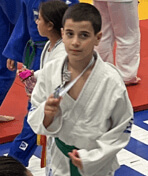
Everything you need to know about sports injuries in children
We all know how good sports are for our physical and mental health, and as parents, we prefer our children to play outside rather than sit in front of a screen or phone…
Physical exercise in teenagers has been shown to reduce the risk of smoking, alcohol, and drug abuse, and even decrease the chances of failing in high school!
Nonetheless, we must keep in mind that those exposed to frequent and prolonged physical exercise are also at higher risk of sports injuries.
The topic of sports injuries in children has been summarized below by Dr Ronen Sever, an excellent pediatric orthopedist.
You can find more information about him under our list of recommended physicians by Dr Efi.
What is the difference between sports injuries in adults and children?
In general, the field of sports injuries is wide and includes traumas such as strains and fractures, injuries from excess training like stress fractures, head traumas, and even effects on the body’s hormonal axes and sexual development.
Sports injuries in children are a subcategory of these injuries, and they differ from adult injuries simply because children are not small adults.
The main difference is that children grow. In addition to being softer and weaker, their bones have growth regions at their ends called growth plates (epiphysis and apophysis). These areas are more prone to injury due to the mechanical characteristics of bones. Injury to these areas can, in the worst-case scenario, lead to full or partial cessation of growth, which may cause differences in limb length, deformities, a limp, or even joint dislocation.
Due to the need for accurate and guided therapy in these types of fractures, monitoring and management by a pediatric orthopedist is recommended both in the acute phase—to determine the need for casting, splinting, or surgical treatment—and later, to monitor symmetrical growth and development.
An additional difference that distinguishes pediatric injuries from adult injuries is related to the soft tissues in children: tendons, ligaments, muscles, and cartilage.
At a young age, most of these components are more flexible than in adults, putting them at greater risk of joint dislocation, imbalance, and strains. On the other hand, some of these components are even stronger than bones, so injuries to ligaments in adults (such as a tear in the anterior cruciate ligament—ACL) can cause avulsion fractures in children (such as in the tibial eminence).
Examples of common sports injuries in children
Osgood-Schlatter disease injury
One of the most common injuries I see among young athletes, usually football or basketball players.
This injury manifests as pain in the front of the shin, close to the knee, where the patellar tendon connects.
It is characterized by pain, swelling, and tenderness at the front of the proximal shin. The pain occurs mainly during or after physical exertion, persists for several hours, and typically resolves by the next training session.
The child reports tenderness and swelling in the area and difficulty flexing the knee (such as squatting). They also often find it difficult to kneel.
The pain stems from inflammation in this relatively weak area where the patellar tendon attaches to the shin, and the body’s attempt to reduce that inflammation.
How is Osgood-Schlatter treated? Usually by reducing training intensity and physiotherapy focused on stretching exercises. Sometimes a special knee brace, cooling the knee, or anti-inflammatory medication can be helpful.
The child may be left with a bony bump on the proximal shin that can make kneeling uncomfortable even in adulthood.
Since Osgood-Schlatter is very common, we have dedicated an entire chapter to it — I invite you all to read it.
Meniscal tear in the knee
Another common injury that requires quick and accurate therapy.
Meniscal injuries are not specific to children, but unlike adults, meniscal tears in children can sometimes be treated with sutures that preserve the meniscus, rather than debridement which removes the torn part.
Children have a better potential for healing, but timing is critical—the earlier the suture, the better the chances of healing.
When an athlete reports a twisting injury to the knee followed by a loud “pop” sound, swelling, and a locked knee (unable to straighten or bend), a bucket handle meniscal tear is suspected and requires prompt diagnosis and treatment.
In these cases, I recommend an MRI of the knee as soon as possible to detect the injury and plan surgery if needed.
While there is no strict time limit, the longer the meniscus is detached, the harder it is to repair, and the less suitable it is for preservation, which can reduce knee function long-term.
What about hormonal effects in children who train at a professional level?
An additional “sports injury” unique to children is the effect on the body’s hormonal axis, which can negatively affect growth and development.
Children—especially girls—who train intensively for prolonged periods subject their bodies to significant stress.
In response, the body secretes hormones such as cortisol to cope with stress, but chronic secretion can suppress growth, bone density, sexual development, and even cause psychological issues.
How to avoid this?
Parents need to be aware of the risks and monitor for changes in behavior, learning, growth, or sexual development.
It is important that training programs are organized with scheduled rest periods throughout the year, rather than continuous high-intensity training.
Of course, if concerns arise, consulting your pediatrician is always the best course of action.
How do you prevent sports injuries in children and teenagers?
Injury prevention is a growing focus in orthopedics.
Together with other fields, efforts have been made to reduce risks of acute and overuse injuries.
For example, young professional football players follow protocols to strengthen neural feedback mechanisms to reduce injuries from falls, tackles, or jumps.
Trainers and sports doctors educate athletes and parents about training hours, restrictions on training and weight lifting, and coordinate with nutritionists and sleep specialists to ensure optimal recovery.
In summary, as a pediatric orthopedist specializing in sports injuries, I prefer watching your children play and train rather than seeing them in my office.
Nonetheless, in any case of a sports-related injury, please consult a pediatric orthopedist specializing in this field for prompt and thorough treatment.
For comments and questions, please register
